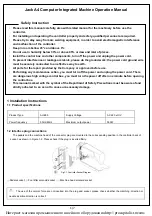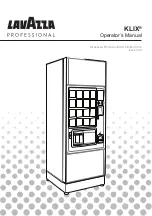
- 72 -
8) ベッド内の下スプロケット止めねじ
!1
をゆるめ、針送り用の針と送り歯のタイミングに合わせてください。
※ 上下送りカムを回らないように固定し、はずみ車を回してタイミングを変更します。
※ 針送りと下送りでは、針と送りのタイミングが約 180°異なります。
※ 針送りの場合は、送り歯が上昇方向で送り歯上面と針板上面が一致した時、針が下降方向で針先
と針板上面が一致するタイミングで合わせるのが一般的です。
ただし、厚物仕様および低押え圧仕様の場合は、針先が針板上面より 4mm 程度上で合わせます。
9) 送りタイミング合わせが終わったら、下スプロケット止めねじ
!1
(2 本)をしっかりと締め付けます。
10) 送りタイミング調整後、送り歯の針穴と針のズレを再確認してください。
※ ズレている場合は、水平送り台腕をゆるめ送り歯の前後位置を再調整してください。
8) Loosen setscrew
!1
in the lower sprocket inside the machine bed and adjust the timing between the needle and the feed
dog for the needle feed.
* Fix the feed driving cam so that it does not turn, and turn the handwheel to change the timing.
* The timing between the needle and the feed dog for the needle feed is approximately 180
˚
different from that for the
bottom feed.
* In case of the needle feed, normally, adjust the timing so that the needle tip aligns with the top surface of throat plate in
the descending direction of the needle when the top surface of feed dog aligns with the top surface of throat plate in the
ascending direction of the feed dog.
For the sewing machines for heavy-weight materials and those with a low presser foot pressure, however, adjust the
needle tip to approximately 4 mm from the top surface of throat plate.
9) After completion of adjusting the feed timing, securely tighten two setscrews
!1
in the lower sprocket.
10) After the feed timing adjustment, check again the slip between the needle hole of feed dog and the needle.
* If there is a slip between them, loosen the feed rocker base arm and re-adjust the longitudinal position of the feed dog.
8) Die Feststellschrauben
!1
am unteren Kettenrad im Maschinenbett lösen, und die Synchronisierung zwischen der Nadel
und dem Transporteur für den Nadeltransport einstellen.
* Den Transportantriebsnocken
fi
xieren, so dass er sich nicht dreht, und dann das Handrad drehen, um die
Synchronisierung zu verändern.
* Die Synchronisierung zwischen der Nadel und dem Transporteur für den Nadeltransport ist um etwa 180° von derjenigen
für den Untertransport verschoben.
* Im Falle des Nadeltransports wird die Synchronisierung normalerweise so eingestellt, dass die Nadelspitze im
Abwärtshub der Nadel auf die Ober
fl
äche der Stichplatte ausgerichtet ist, wenn die Oberseite des Transporteurs im
Aufwärtshub mit der Ober
fl
äche der Stichplatte
fl
uchtet.
Im Falle von Nähmaschinen für schwere Stoffe und solchen mit niedrigem Nähfußdruck ist die Einstellung jedoch so
vorzunehmen, dass die Nadelspitze ca. 4 mm über der Ober
fl
äche der Stichplatte liegt.
9) Nach der Einstellung der Transportsynchronisierung die zwei Feststellschrauben
!1
am unteren Kettenrad wieder sicher
anziehen.
10) Nach der Einstellung der Transportsynchronisierung muss der Schlupf zwischen dem Stichloch des Transporteurs und der
Nadel erneut überprüft werden.
* Falls Schlupf zwischen den beiden Teilen vorhanden ist, den Transportschwinghebel-Basisarm lösen, und die
Längsposition des Transporteurs neu einstellen.
!1
標準:針先一致
Standard : Needle tip aligns with top surface of
throat plate.
Standard : Die Nadelspitze erreicht die Oberseite der
Stichplatte.
Standard : Pointe de l’aiguille au niveau de la
surface supérieure de la plaque à aiguille.
Estándar : La punta de la aguja se alinea con la
super
fi
cie superior de la placa de agujas.
Standard : La punta d’ago è allineata alla super
fi
cie
superiore della placca ago.
标准 : 针尖一致
厚物 / 低押え圧:4mm
Heavy-weight materials /
low presser foot pressure: 4 mm
Schwere Stoffe / niedriger
Nähfußdruck: 4 mm
Tissus épais/pression du pied
presseur faible : 4 mm
Materiales pesados / baja
presión de pie prensatelas: 4mm
Materiali pesanti /bassa pressione
del piedino premistoffa: 4 mm
厚料 / 低压脚压力 : 4mm




































